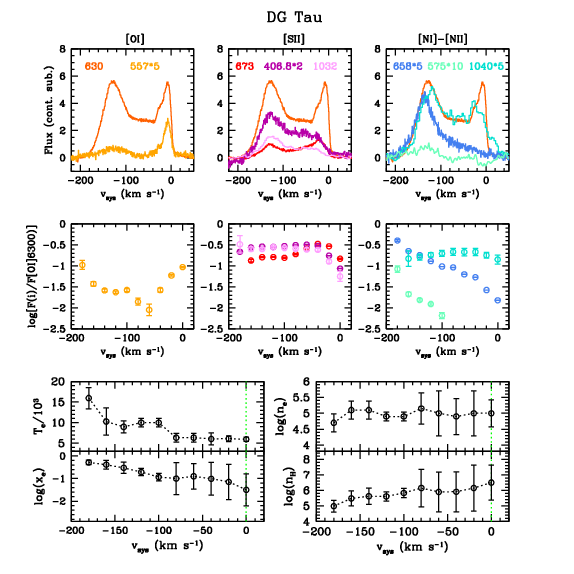GIARPS unravels the jet acceleration zone in young low-mass stars
Accretion of matter and ejection through jets and winds are the most important processes that characterize the T Tauri stage of low-mass stellar evolution. These are also the main mechanisms concurring to disperse the gas in circumstellar disks, so they affect the disk evolution and set the initial conditions for planet formation, ultimately determining the architecture of planetary systems. Such processes occur on spatial scales (fraction of au) that cannot be resolved by present instrumentation. However, a detailed understanding of the origin of the various phenomena (atomic/molecular jets, slow winds, accretion columns, circumstellar disk) may be obtained from the coupling of high spectral resolution and wide wavelength coverage. With its unique combination of the HARPS-N and GIANO-B instruments, GIARPS is the ideal observing mode to perform this kind of investigation.
GHOsT (GIARPS High-resolution Observations of T Tauri stars, P.I. S. Antoniucci, OAR) is an INAF project involving many researchers from different institutes, who have participated in the JEDI (jets and disk at INAF) collaboration since 2014. Its aim is to determine, for the first time in a statistically significant, homogeneous, and self-consistent way, a quantitative description of the main processes taking place in the star-disk interaction region of T Tauri stars, together with the properties of the central star. The observed sample comprises young stars of the Taurus-Auriga star-forming region, covering a wide range of masses, mass accretion rates, and disk properties.
The first GHOsT work (Giannini et al. 2019) is a pilot paper dedicated to a physical and kinematic characterization of the outflows from T Tauri stars. Collimated jets of matter are an ubiquitous phenomenon of the protostellar and pre-main sequence phase of stellar evolution. According to well-established models, jets are launched through a magneto-centrifugal process and can efficiently remove excess angular momentum from the star-disk system, thus allowing accretion of matter onto the central star. In addition, slower and poorly collimated winds can also be present, which arise from a larger area of the disk and can significantly contribute to its evolution and dispersal.
The best physical probes of the excitation and ionization conditions in the jet formation region are the forbidden lines of abundant atomic species. Several studies have been dedicated to this subject (see e.g., Frank et al. 2014), which however rely on very few line ratios exploiting only a limited diagnostic range of temperature, density, and gas ionization degree. The GIARPS observations have allowed us to get the most detailed picture to date of the physical conditions in the jet and winds formation region, thanks to the combination of many optical/near-infrared lines of O, S, N, and Fe, and to the high spectral resolution, which allows us to identify different kinematic components within the spectral line profiles.
As an example of the results obtained, the profiles of several bright lines in the DG Tau jet are shown in the figure as a function of the gas velocity with respect to the star. The lines typically exhibit a low-velocity component, peaking close to the rest velocity, and a blue-shifted, high-velocity component. The first represents a slow, uncollimated wind driven by the local magnetic field or originating from the photo-evaporation of the gaseous disk, while the second is the high-velocity (v > 100 km/s), highly-collimated jet that often extends up to fractions of parsec from the star. In the bottom panels, the variation of the physical parameters is presented. Noticeably, both temperature and ionization increase with increasing velocity, while the density diminishes as the jet propagates in the interstellar medium. It is interesting to note that all the physical parameters smoothly change with velocity, therefore suggesting a common emission mechanism for the two velocity components. These results are unexpected and very promising. If confirmed on a robust statistical basis, which we aim to obtain at the end of our project, they will represent a very strong observational benchmark for jet launching and disk evolution models. So, stay tuned for more news from GHOsT!

Upper panels: Examples of the continuum-subtracted lines of DG Tau used in the fitting procedure. Different lines are depicted with different colors according to the labels. For a better visualization, some fluxes have been multiplied by a constant as indicated. The [OI]630 nm profile, which is taken as a reference in the fitting, is shown for comparison in each panel. Middle panels: De-reddened flux ratios with respect to [OI]630 nm computed in bins of 20 km/s. Colors have the same meaning as in the top panels. Bottom panels: Gas parameters (electron temperature and density, fractional ionization, and total density) plotted as a function of the bins of velocity. The green vertical dotted line marks the position of the rest velocity.
Link to the paper: https://ui.adsabs.harvard.edu/abs/2019A%26A...631A..44G/abstract

